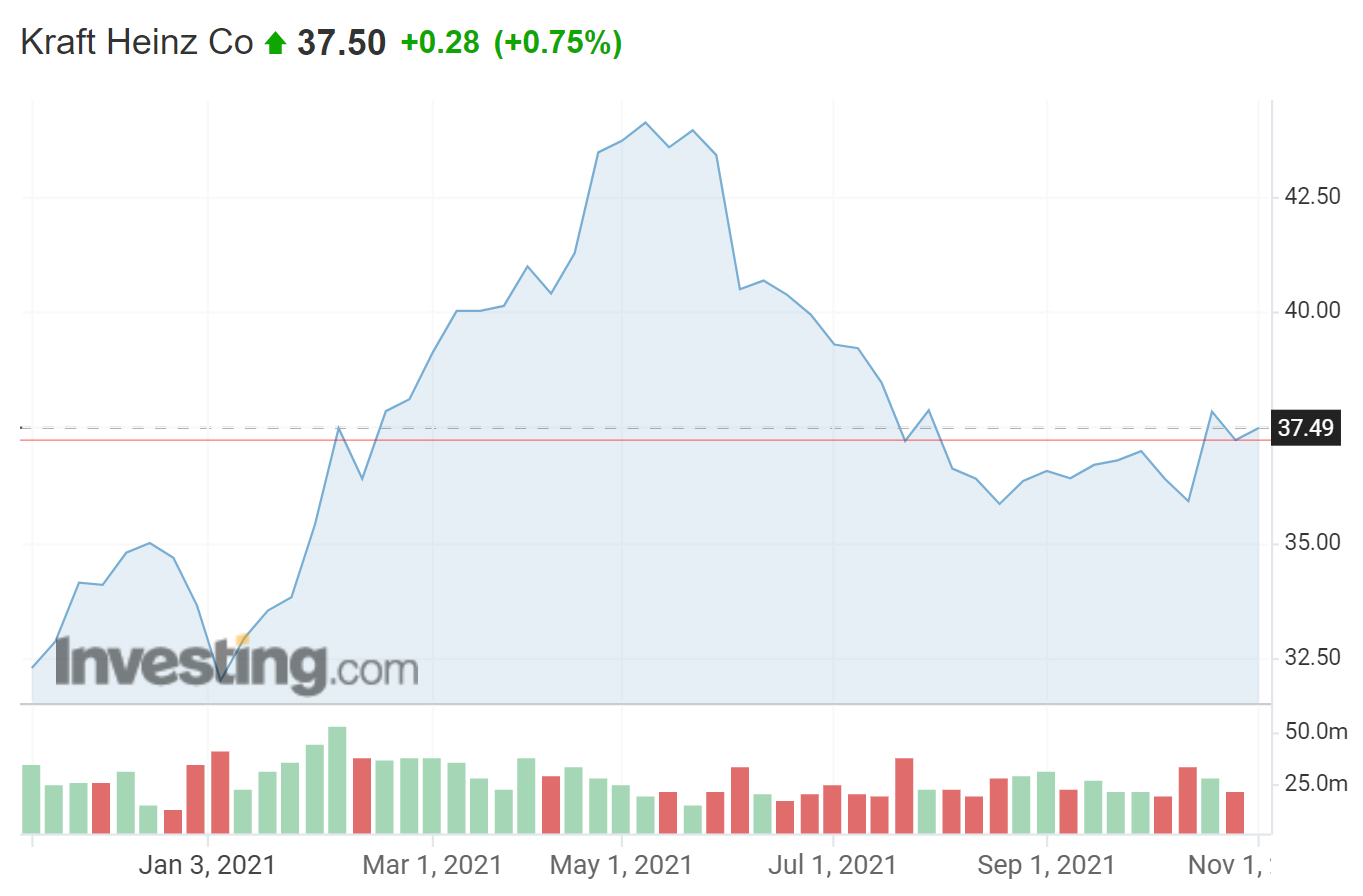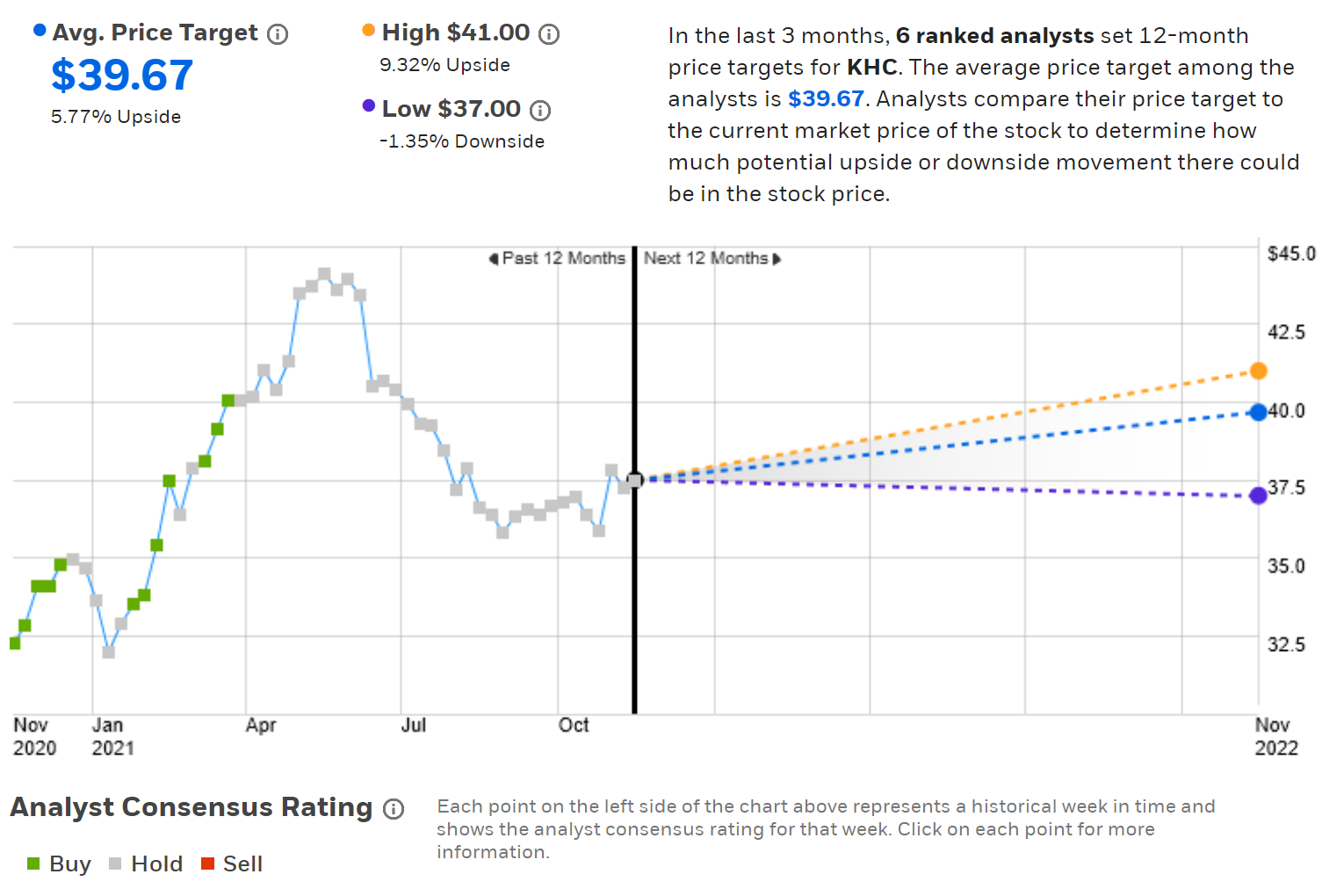- Kraft and Heinz merged into Kraft Heinz Company (KHC) in 2015
- KHC has struggled in the years since
- The company faces additional challenges from inflation, labor shortages, and supply chain disruptions
- Both the Wall Street analyst consensus outlook and the market-implied outlook indicate a neutral rating
The Kraft Heinz Company (NASDAQ:KHC) reported Q3 earnings on Oct. 27, beating the consensus expectation for EPS by 12.46%. Since closing at $36.40 on Oct. 27, the shares of the Pittsburgh-based packaged foods company have risen about 3%.
The shares are currently 15.7% below the YTD high close of $44.50 on May 24, 2021.

Source: Investing.com
It is no secret that the food and beverage manufacturer has not thrived since the merger of Kraft and Heinz in 2015. The 5-year annualized total return on KHC is -10.3% per year, as compared to +18.9% per year for the S&P 500 over the same period.
The consensus estimated forward earnings growth indicates that the company will continue to lag. Expected EPS growth for the next 3-5 years is 1.35% per year.
With a dividend yield of 4.3%, KHC may attract some income investors, but the 5-year dividend growth rate is -11.2% due to the dividend cut in 2019 and it remaining constant ever since. KHC provides no confidence in the future income stream. The company is choosing to use earnings to strengthen the balance sheet at the expense of the dividend.
To invest in KHC, one must expect that the merger of Kraft and Heinz will eventually provide scale benefits as the company overcomes the growing pains associated with bringing together two organizations. However, there is little cause to believe that things will improve over the next year or two.
I last wrote about KHC on Mar. 17, 2021. The situation then was essentially the same as today and there was little reason then to think that things would improve in the near-term. So I assigned KHC a neutral rating. In the 8 months since that article, the total return on KHC is -1.77%, as compared to a price gain of almost 19% for the S&P 500.
Over the past 8 months, food companies have been facing additional headwinds from inflation, the shortage of workers, and supply chain problems. KHC has acknowledged the challenges in these areas (also see this article).
When I analyzed KHC in March, I relied on two forms of consensus outlooks. The first was the well-known Wall Street analyst consensus rating and 12-month price target. Research suggests that the consensus 12-month price target has meaningful predictive value.
The second consensus view that I looked at was the market-implied outlook, a probabilistic forecast of price returns that reflects the consensus views of buyers and sellers of options. In March, the Wall Street analyst consensus was bullish, but the 12-month price target was only 1% above the share price at that time. The market-implied outlook to early 2022 was bearish, however. I compromised with a neutral rating overall.
The price of an option on a stock reflects the market’s consensus estimate of the probability that the price of the stock will rise above (call option) or fall below (put option) a specific level (the strike price) between now and when the option expires. By analyzing the prices of call and put options at a range of strike prices, all with the same expiration date, it is possible to calculate a probabilistic forecast that reconciles the option prices. This is the market-implied outlook.
In the 8 months since my last analysis, KHC has fallen even as the broader market has soared and the food services industry is facing increasing hurdles from inflation, unemployment, and supply chain disruptions. I have updated the market-implied outlook for KHC and compared it to the current Wall Street consensus outlook to see how things have changed.
Wall Street Consensus Outlook For KHC
E-Trade calculates the Wall Street consensus outlook using ratings and 12-month price targets from 6 ranked analysts who have published views in the past 90 days. The consensus rating is neutral and the consensus 12-month price target is $39.67, slightly higher than in March ($39).
With the share price declines over the past 8 months, the expected 12-month price return, 5.77%, is considerably higher than it was in March. I am somewhat ambivalent about increases in the expected price appreciation that are largely due to falling share prices. All 6 of the analysts assign a neutral rating to KHC.

Source: E-Trade
Investing.com’s calculation of the Wall Street consensus outlook combines the views of 20 analysts. The consensus rating is neutral and the consensus 12-month price target is 8.8% above the current share price.

Source: Investing.com
The two calculations of the Wall Street consensus are generally consistent, with a neutral rating and expected 12-month price appreciation of 5.8% from E-Trade and 8.8% from Investing.com.
For a large value stock like KHC, 12-month price appreciation in this range, combined with the 4.3% dividend yield, would be quite attractive and is well above the average returns over the past 15 years for the packaged foods industry.
Market-Implied Outlook For KHC
I have analyzed put and call options at a range of strike prices, all expiring on Jan. 21, 2022, to generate the market-implied outlook for KHC for the 2.2-month period from now until that date. I have also calculated the market-implied outlook for the 7-month period from now until June 17, 2022 using options that expire on that date.
The standard presentation of the market-implied outlook is in the form of a probability distribution of price returns, with probability on the vertical axis and return on the horizontal.

Source: Author’s calculations using options quotes from E-Trade
The market-implied outlook is generally symmetric, with comparable probabilities of positive and negative returns. Rather than having a single well-defined peak in probabilities, there are two small peaks at price returns of 0% and -3% for the next 2.2 months. The annualized volatility calculated from this distribution is 24.1%.
To make it easier to directly compare the probabilities of positive and negative return, I rotate the negative return side of the distribution about the vertical axis (see chart below).

Source: Author’s calculations using options quotes from E-Trade. The negative return side of the distribution has been rotated about the vertical axis.
From this view, it is evident that the probabilities of negative returns are consistently higher than for positive returns of the same magnitude. This is a slightly bearish outlook for price return.
Theory suggests that the market-implied outlook may be expected to have a negative bias because investors, in aggregate, tend to be risk averse and thus will be willing to overpay for put options. There is no way to robustly correct for this effect. Considering the potential for this bias, I conclude that the market-implied outlook to mid January is neutral with perhaps a slight bearish tilt.
The market-implied outlook to the middle of 2022, calculated using options that expire on June 17, 2022, is consistent with the shorter-term outlook. The probabilities of negative returns are slightly elevated (vs. positive returns) for the next 7 months. The annualized volatility calculated from this distribution is 26.5%.

Source: Author’s calculations using options quotes from E-Trade. The negative return side of the distribution has been rotated about the vertical axis.
The market-implied outlooks for KHC to Jan. 21, 2022 and to June 17, 2022 are similar and support a rating of neutral on KHC, perhaps with a slight negative tilt.
Summary
KHC has not thrived since the merger, and current conditions are not going to help in the coming year. The Wall Street consensus outlook is neutral, albeit with a consensus 12-month price target that is 5.8% to 8.8% above the current level.
Combined with the dividend, the expected total return for the next year is 10.1% to 13.1%, for an average of 11.6%. As a rule of thumb for a buy rating, I want to see an expected 12-month total return that is at least half the expected volatility. Averaging the volatilities calculated from the market-implied outlooks, the expected volatility is 25.3%.
The average of the two consensus outlooks for return falls slightly short of the criterion for a buy. The market-implied outlooks for KHC to early- and mid-2022 are neutral. My final overall rating for KHC is maintained at neutral.
